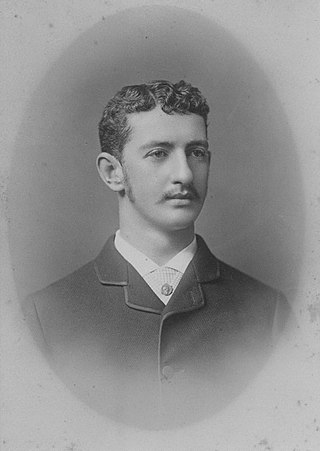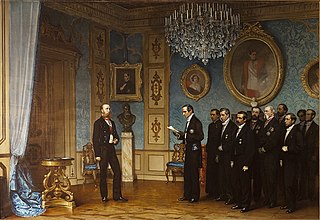Mexican Empire may refer to:
- First Mexican Empire, the regime under Agustín de Iturbide (Agustín I) from 1821 to 1823
- Second Mexican Empire, the regime under Archduke Maximilian of Austria (Maximilian I) from 1864 to 1867
Mexican Empire may refer to:

Agustín de Iturbide, full name Agustín Cosme Damián de Iturbide y Arámburu and also known as Agustín of Mexico, was a general in the Mexican army then a politician, becoming Emperor during the First Mexican Empire. During the country's war of independence, he built a successful political and military coalition that took control in Mexico City on 27 September 1821, decisively gaining independence for Mexico. After securing the secession of Mexico from Spain, Iturbide was proclaimed president of the Regency in 1821; a year later, he was proclaimed Emperor, reigning from 19 May 1822 to 19 March 1823. In May 1823 he went into exile in Europe. When he returned to Mexico in July 1824, he was arrested and executed. He designed the Mexican flag.

Maximilian I was an Austrian archduke who became emperor of the Second Mexican Empire from 10 April 1864 until his execution by the Mexican Republic on 19 June 1867.

Charlotte of Belgium, known by the Spanish version of her name, Carlota, was by birth a Princess of Belgium and member of the House of Wettin in the branch of Saxe-Coburg and Gotha. As the wife of Archduke Maximilian of Austria, Viceroy of Lombardy–Venetia and later Emperor of Mexico, she became Archduchess of Austria and Empress of Mexico. She was daughter, granddaughter, sister, sister in-law, cousin and wife of reigning or deposed sovereigns throughout Europe and Mexico.

Agustín de Iturbide y Green was the grandson of Agustín de Iturbide, the first emperor of independent Mexico, and his consort Ana María Huarte.

The Second Mexican Empire, officially the Mexican Empire, was a constitutional monarchy established in Mexico by Mexican monarchists in conjunction with the Second French Empire. The period is sometimes referred to as the Second French intervention in Mexico. Emperor Napoleon III of France, with the support of the Mexican conservatives, clergy, and nobility, established a monarchist ally in the Americas intended as a restraint upon the growing power of the United States. It has been viewed as both an independent Mexican monarchy and as a client state of France. Invited to become emperor of Mexico by Mexican monarchists who had lost a bloody civil war against Mexican liberals was Austrian Archduke Maximilian, of the House of Habsburg-Lorraine, who had ancestral links to rulers of colonial Mexico. His wife and empress consort of Mexico was the Belgian princess Charlotte of the House of Saxe-Coburg and Gotha, known in Mexico as "Carlota".

The Emperor of Mexico was the head of state and ruler of Mexico on two non-consecutive occasions in the 19th century.

There were three Imperial Orders of the Mexican Empire, which were Orders of chivalry created to reward Heads of state and prominent people during the two periods of the Mexican Empire—the Imperial Order of Guadalupe, the Imperial Order of the Mexican Eagle, and the Imperial Order of Saint Charles.
By the Grace of God is a formulaic phrase used especially in Christian monarchies as an introductory part of the full styles of a monarch. For example in England and later the United Kingdom, the phrase was formally added to the royal style in 1521 and continues to be used to this day. For example, on UK coinage, the abbreviation DG still appears.

The Imperial Crown of Mexico was the crown created for the Sovereign of Mexico on two separate occasions in the 19th century. The first was created upon the Declaration of Independence of the Mexican Empire from the kingdom of Spain in 1821, for the First Mexican Empire. The second crown was created upon the decree of the Assembly of Notables in 1863 for the Second Mexican Empire.

María Josepha Sophia de Iturbide was the head of the Imperial House of Mexico from 1925 to 1949. A modest and very religious lady, she played no political role whatsoever. She married twice and had two daughters.

Agustín Jerónimo de Iturbide y Huarte was the eldest son of the first Emperor of Mexico, Agustín I of Mexico. He was the heir apparent to the First Mexican Empire and a member of the Imperial House of Iturbide. Later in life, he served as a military officer in South America and also worked as a diplomat for the United Mexican States at the Mexican embassy in the United States and in London, after his military career had ended in South America.

The Royal and Pontifical University of Mexico was founded on 21 September 1551 by Royal Decree signed by Charles I of Spain, in Valladolid, Spain. It is generally considered the first university officially founded in North America and second in the Americas.

The House of Iturbide is a former Imperial House of Mexico. It was founded by the Sovereign Mexican Constituent Congress on 22 June 1822 when the newly independent Mexican congress confirmed Agustín I's title of Constitutional Emperor of Mexico. He was baptized with the names of Saints Cosmas and Damian at the cathedral there. The last name Iturbide was originally from the Basque Country, Spain.

The Mexican nobility were a hereditary nobility of Mexico, with specific privileges and obligations determined in the various political systems that historically ruled over the Mexican territory.
Prince of Mexico may refer to:

Josefa de Iturbide y Huarte was the daughter of Agustín de Iturbide and Ana María Huarte who received the title of Mexican Princess during the First Mexican Empire by the Constituent Congress and Princess of Iturbide during the Second Mexican Empire by Maximilian of Habsburg.

Ángel María José Ignacio Francisco Xavier de Iturbide y Huarte was the second son of Agustín de Iturbide and Ana María Huarte who received the title of Mexican Prince during the First Mexican Empire by the Constituent Congress.
The First Mexican Empire, established in 1821, with Agustín de Iturbide proclaimed as Emperor in 1822, was abolished in 1823.

Monarchism in Mexico is the political ideology that defends the establishment, restoration, and preservation of a monarchical form of government in Mexico. Monarchism was a recurring factor in the decades during and after Mexico's struggle for independence.

The Imperial Order of the Mexican Eagle was an Order of Chivalry created by emperor Maximiliano I of Mexico during the Second Mexican Empire on January 1st of 1865. It was one of three Mexican Imperial Orders. It survives partly in name as the Order of the Aztec Eagle.